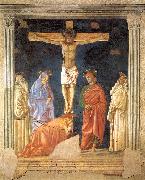Wholesale Oil Painting No Minimum |
|||||||||||
|
|
|||||||||||

|
|||||||||||
|
|
|
||||||||
Andrea del CastagnoItalian c1421-1457 Andrea del Castagno Location Italian c1421-1457 Andrea del Castagno Location Italian painter. He was the most influential 15th-century Florentine master, after Masaccio, of the realistic rendering of the figure and the representation of the human body as a three-dimensional solid by means of contours. By translating into the terms of painting the statues of the Florentine sculptors Nanni di Banco and Donatello, Castagno set Florentine painting on a course dominated by line (the Florentine tradition of disegno), the effect of relief and the sculptural depiction of the figure that became its distinctive trait throughout the Italian Renaissance, a trend that culminated in the art of Michelangelo. |
||||||||
|
|
||||||||
Crucifixion and Saints
Crucifixion and Saints Painting ID:: 4743 |
1440-41
Fresco
Ospedale Santa Maria Nuova, Florence 1440-41 Fresco Ospedale Santa Maria Nuova, Florence |
|||||||
|
|
||||||||
|
Fra Angelico Fra Angelico Galleries b.c. 1400, Vicchio, Florence d.Feb. 18, 1455, Rome Fra Angelico (c. 1395 ?C February 18, 1455), born Guido di Pietro, was an Early Italian Renaissance painter, referred to in Vasari's Lives of the Artists as having "a rare and perfect talent". Known in Italy as il Beato Angelico, he was known to his contemporaries as Fra Giovanni da Fiesole (Brother John from Fiesole). In Giorgio Vasari's Lives of the Artists, written prior to 1555, he was already known as Fra Giovanni Angelico (Brother Giovanni the Angelic One). Within his lifetime or shortly thereafter he was also called Il Beato (the Blessed), in reference to his skills in painting religious subjects. In 1982 Pope John Paul II conferred beatification, thereby making this title official. Fiesole is sometimes misinterpreted as being part of his formal name, but it was merely the name of the town where he took his vows, used by contemporaries to separate him from other Fra Giovannis. He is listed in the Roman Martyrology as Beatus Ioannes Faesulanus, cognomento Angelicus??"Blessed Giovanni of Fiesole, nicknamed Angelico". Fra Angelico was working at a time when the style of painting was in a state of change. This process of change had begun a hundred years previous with the works of Giotto and several of his contemporaries, notably Giusto de' Menabuoi, both of whom had created their major works in Padua, although Giotto was trained in Florence by the great Gothic artist, Cimabue, and painted a fresco cycle of St Francis in the Bardi Chapel in Santa Croce. Giotto had many enthusiastic followers, who imitated his style in fresco, some of them, notably the Lorenzetti, achieving great success. Crucifixion and Saints 1441-42 Fresco, 550 x 950 cm |
||||||||
|
|
||||||||
|
Prev Next
|
||||||||
|
|
||||||||
|
Related Paintings to Fra Angelico :. |
||||||||
|
|
||||||||
|
CONTACT US |

